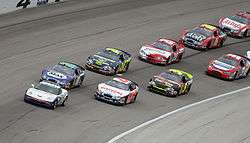NASCAR Xfinity Series
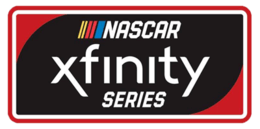 | |
| Category | Stock cars |
|---|---|
| Country | United States |
| Inaugural season | 1982 |
| Manufacturers | Chevrolet · Dodge · Ford · Toyota |
| Tire suppliers | Goodyear |
| Drivers' champion | William Byron |
| Teams' champion | JR Motorsports |
| Makes' champion | Chevrolet |
| Official website | Xfinity Series |
|
| |
The NASCAR Xfinity Series (NXS) is a stock car racing series organized by NASCAR. It is promoted as NASCAR's "minor league" circuit, and is considered a proving ground for drivers who wish to step up to the organization's top level circuit, the Monster Energy NASCAR Cup Series. NXS events are frequently held as a support race on the day prior to a Cup Series event scheduled for that weekend.
The series was previously called the Budweiser Late Model Sportsman Series in 1982 and 1983, the NASCAR Busch Grand National Series from 1984 through 2003, the NASCAR Busch Series from 2004 through 2007, and the NASCAR Nationwide Series from 2008 through 2014. It is currently sponsored by Comcast via its consumer cable brand Xfinity.[1][2]
History
The series emerged from NASCAR's Sportsman division, which had been formed in 1950 as NASCAR's short track race division. It was NASCAR's fourth series (after the Modified and Roadster series in 1948 and Strictly Stock in 1949). The sportsman cars were not current model cars and could be modified more, but not as much as Modified series cars.[3] It became the Late Model Sportsman Series in 1968, and soon featured races on larger tracks such as Daytona International Speedway. Drivers used obsolete Grand National (now Monster Energy NASCAR Cup Series) cars on larger tracks but by the inception of the touring format in 1982, the series used older compact cars. Short track cars with relatively small 300 cubic inch V-8 motors were used. Drivers used smaller current year models featuring V6 motors.
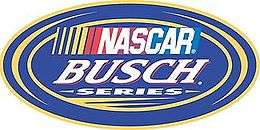
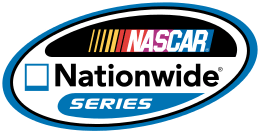


The modern-day Xfinity Series was formed in 1982, when Anheuser-Busch sponsored a newly reformed late-model sportsman series with its Budweiser brand. The series switched sponsorship to Busch in 1984. It was renamed in 1986 to the Busch Grand National Series.
Grand National was dropped from the series' title in 2003 as part of NASCAR's brand identity (the Grand National name was now used for the Busch East and Winston West series as part of a nationwide standardization of rules for NASCAR's regional racing). Anheuser-Busch dropped the sponsorship in 2007; Nationwide Insurance took over the sponsorship for the 2008 season, renaming it the Nationwide Series.[4] The Nationwide sponsorship was a seven-year contract, and did not include the banking and mortgage departments of Nationwide. The sponsorship reportedly carried a $10 million commitment for 2008, with 6% annual escalations thereafter.[5]
On September 3, 2014, it was announced that Comcast would become the new title sponsor of the series via its cable television and internet brand Xfinity, renaming it the Xfinity Series.[6] In 2016, NASCAR implemented a seven-race Chase system similar to the one used in the NASCAR Cup Series.[7]
On August 23, 2018 NASCAR announced that the field size of the NXS will be cut from 40 to 38.
Races held outside the U.S.
On March 6, 2005, the series held its first race outside the United States, the Telcel-Motorola 200. The race was held in Mexico City, Mexico at the Autodromo Hermanos Rodriguez, a track that has held Formula One and Champ Car races in the past. It was won by Martin Truex Jr. On August 4, 2007, the series held its second race outside the United States, at the Circuit Gilles Villeneuve in Montreal, Quebec, another road course. It was won by Kevin Harvick, while Quebec native Patrick Carpentier finished second. In July 2008, NASCAR announced that the Nationwide Series would not return to Mexico City in 2009, and in 2012 they announced that it would not be returning to Montreal in 2013.
Chase for the championship
In 2016, the NXS and the NASCAR Camping World Truck Series adopted a playoff format similar to the NASCAR Cup Series Chase for the Championship. Unlike the NASCAR Cup Series, whose Chase consists of four rounds, the Xfinity Series and Truck Series both use a three-round format. After each of the first two rounds, the four Chase grid drivers with the fewest season points are eliminated from the grid and Chase contention. The best-placed driver overall from the four Dash 4 Cash races advances to the Chase.
- Round of 12 (races 27–29)
- Begins with 12 drivers who qualify for the Chase grid with 2,000 points
- Round of 8 (races 30–32)
- Begins with 8 drivers, each with 3,000 points
- Championship 4 (final race)
- The last four drivers in contention for the season title will have their points reset to 4,000 points, with the highest finisher in the race winning the NXS title.
- Round of 12 (races 27–29)
Television broadcasting
United States
In the 1980's, races were sparsely shown, mainly by ESPN if they were covering the cup race at the same track. Starting in 1990, more races began to be shown. By the mid 1990's, all races were shown. Most standalone races were aired on TNN, which helped grow coverage of the series, while races that were companion races with Winston Cup dates aired on the network airing the Cup race. TNN aired some of these races, which also aired on CBS, NBC, ESPN, ABC and TBS.
From 2001 until 2006, Fox Sports covered the entire first half of the Busch Grand National season, while NBC and TNT both aired races during the second half, with Turner Sports producing all the coverage for both networks. However, in even numbered years, coverage was changed, with the opening race at Daytona airing on NBC in 2004, on TNT in 2002 and 2006 (due to NBC's coverage of the Winter Olympics) and the track's July race airing on FX. Large portions of Fox's coverage aired on sister network FX, with a few marquee events on the network itself.
From 2007 until 2014, ESPN was the home of the renamed Nationwide Series. Generally four races per season aired on ABC, with the remainder on ESPN, ESPN2, and ESPNews. Early in ESPN's run, ESPN Classic was used for NNS overflow, however with less carriage of that network, this practice ended. Fox Sports did make a return to the series, airing the 2011 Bubba Burger 250 at Richmond on Speed Channel, due to ESPN giving up its exclusive rights to the race because of programming conflicts.
In 2015, the NXS returned to FOX Sports during the first half of the season. Like the previous time Fox held rights to the series, most of the coverage aired on cable, though this time it aired on Fox Sports 1. Four races will air on Fox itself. The second half of the NXS season will be televised by NBC Sports. Four races will air on NBC itself, while the others will air on NBCSN.
Latin America
The NXS is available in most Latin American countries on cable and satellite TV. Since 2006, Fox Sports 3 (formerly called SPEED until 2013) carries live coverage of all events. The races are also shown on Fox Sports Latin America, some of them live and some tape-delayed depending on the network's schedule. Televisa Deportes also broadcast a 30-minute recap every Sunday morning on national television in Mexico. In Brazil Fox Sports 2 carries all three series.
Australia
Network Ten's additional high-definition service, ONE, began broadcasting races from the NXS live or near live during the 2008 season. ONE continued to air highlights packages of each race until the end of 2014. Broadcasts of the series are now exclusively shown on the Fox Sports pay TV channels.
Canada
All races are live on TSN channels using FOX's or NBC's coverage. Also, races are broadcast on RDS or RDS2 in French using the world feed produced by NASCAR.
Europe
Since 2012, Motors TV broadcasts all Xfinity races live, delayed and highlights, until late 2014.
The Portuguese channel, Sport TV broadcasts every Xfinity races live.
Asia
All races are live on Sports Illustrated Television channels[8] using FOX's or NBC's coverage with highlights on Fox Sports Asia.
NASCAR Cup Series drivers in the Xfinity Series
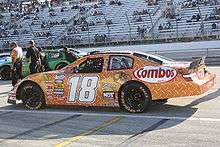
Since the early days of the Xfinity Series, many NASCAR Cup Series drivers have used their days off to drive in the NXS. This can be for any number of reasons, most prominent or often claimed is to gain more "seat time", or to familiarize themselves with the track. Examples of this would be Dale Earnhardt, who won the very first NXS race, and Kyle Busch, who has won the most races in NXS history.
In recent years, this practice had been dubbed "Buschwhacking" by its detractors. The colloquialism originated when Anheuser-Busch was the main sponsor of the series by combining the name "Busch" with the term "bushwhacker," but it has gradually fallen out of use since Anheuser-Busch's sponsorship ended.
Critics claim that NASCAR Cup Series drivers racing in the NXS take away opportunities from the NXS regulars, usually younger and less experienced drivers. On the other hand, many fans claim that without the NASCAR Cup Series stars and the large amount of fan interest they attract on their own races, the NXS would be inadequate as a high-tier division. In addition, many NXS drivers have welcomed the Cup drivers because it gives them the opportunity to drive with more seasoned veterans.[9]
In 2007, the NASCAR Cup Series began racing with the Car of Tomorrow, a radically new specification different from the NXS. NASCAR Cup Series drivers have admitted that driving the Xfinity car the day before the race does little to help with the NASCAR Cup Series race, as the cars differ greatly. This loosely resulted in the new Nationwide Series car making its debut in the 2010 Subway Jalapeño 250 at Daytona International Speedway. This car has a set-up closer to the current Cup car and some Cup drivers who have tested the car say it has similar handling characteristics. The new car has gone full-time since the 2011 season. In 2007, six out of the top ten drivers in the final point standings were Cup regulars, with Jason Leffler being the only non-Cup driver in that group to win a race in 2007. This number decreased from 2006 when 8 out of 10 drivers were Cup regulars. The decreased number is attributed to Cup regulars running only partial schedules, allowing for more NXS regulars to reach the top ten in points. However, the champions from 2006 to 2010 were all Cup regulars driving the full series schedule (Kevin Harvick, Carl Edwards, Clint Bowyer, Kyle Busch, and Brad Keselowski). As a result, beginning with the 2011 season, NASCAR implemented a rule stating that drivers could only compete for the drivers' championship in one of three national series (NASCAR Cup Series, Xfinity, and Camping World Truck) of the drivers' choosing.
On October 26, 2016, NASCAR announced plans to limit Cup participation in the lower series starting in 2017. Cup drivers who were competing for points in the Cup Series with at least five years of experience in the series would be allowed to compete in up to ten NXS races, but are banned from racing in the series' regular season finale, Chase, and Dash 4 Cash races.[10]
Xfinity Series cars
Comparison with a NASCAR Cup Series Car
With the advent of NASCAR's Car of Tomorrow, NXS cars have become very different from their NASCAR Cup Series counterparts, the main differences being a slightly shorter wheelbase (105" instead of 110"), 100 pounds less weight, and a less powerful engine. In the past, NXS competitors could use makes of cars not used in the Cup series, as well as V-6 engines instead of Cup's V-8s.
In the early 1980s, teams were switching from the General Motors 1971–77 X-Body compact cars with 311-cubic inch engines. Later, teams were using General Motors 1982–87 G-body cars. Ford teams have used the Thunderbird cars consistently.
In 1989, NASCAR changed rules requiring cars to use current body styles, similar to the Cup cars. However, the cars still used V6 engines. The cars gradually became similar to Cup cars.
In 1995, changes were made. The series switched to V-8s with a compression ratio of 9:1 (as opposed to 14:1 for Cup at the time). The vehicle weight with driver was set at 3,300 pounds (as opposed to 3,400 for Cup). The body style changes, as well as the introduction of V-8s, made the two series' cars increasingly similar.
The suspensions, brake systems, transmissions, were identical between the two series, but The Car of Tomorrow eliminates some of these commonalities. The Car of Tomorrow is taller and wider than the current generation vehicles in the Nationwide Series, and it utilizes a front "splitter", opposed to a front valance. The Car of Tomorrow has also been setting pole speeds slower than the NXS cars at companion races.[11]
Previously, Busch Series cars used fuel that contained lead. NASCAR conducted a three-race test of unleaded gasoline in this series that began on July 29, 2006, with a race at Gateway International Raceway. The fuel, Sunoco GT 260 Unleaded, became mandatory in all series starting with the second weekend of the 2007 series, with Daytona being the last race weekend using leaded gasoline.
Another distinction between the cars started in 2008: Goodyear had developed a rain tire for NASCAR road course racing in both series but NASCAR never used them under race conditions. The program was abandoned by the NASCAR Cup Series in 2005, but the Busch Series continued to use rain tires in races at Autodromo Hermanos Rodriguez and Circuit Gilles Villeneuve, since the races could not be planned with rain dates. When rain started to fall at the 2008 NAPA Auto Parts 200, the tires were used in the rain for the first time.[12]
Another distinction was added in 2012, when NASCAR changed the fuel delivery system in the Cup cars from carburetion to fuel injection. NXS cars continue to use carburetors.
Specifications

- Chassis: Steel tube frame with integral safety roll cage – must meet NASCAR standards
- Engine displacement: 5,860 cc (358 cu in) Pushrod V8
- Transmission: 4-speed manual
- Weight: 3,200 lb (1,451 kg) minimum (without driver); 3,400 lb (1,542 kg) minimum (with driver)
- Power output: 650–700 hp (485–522 kW) unrestricted, ≈450 hp (335 kW) restricted
- Torque: 700 N⋅m (520 ft⋅lb)
- Fuel: 90 MON, 98 RON, 94 AKI unleaded gasoline provided by Sunoco 85% + Sunoco Green Ethanol E15
- Fuel capacity: 18 US gal (68 L)
- Fuel delivery: Carburetion
- Compression ratio: 12:1
- Aspiration: Naturally aspirated
- Carburetor size: 390 ft³/min (184 L/s) 4 barrel
- Wheelbase: 110 in (2,794 mm)
- Steering: Power, recirculating ball
- Tires: Slick tires and rain tires provided by Goodyear
- Length: 203.75 in (5,175 mm)
- Width: 75 in (1,905 mm)
- Height: 51 in (1,295 mm)
- Safety equipment: HANS device, seat belt 6-point supplied by Willans
Xfinity "Car of Tomorrow" (CoT)
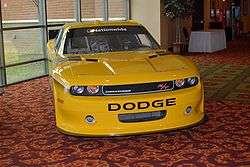
The then Nationwide Series unveiled its "Car of Tomorrow" (CoT) at the July 2010 race at Daytona International Speedway. Before being fully integrated in the 2011 season, it was also used in 2010 races at Michigan International Speedway, Richmond International Raceway and Charlotte Motor Speedway.[13] The Xfinity CoT has important differences from the NASCAR Cup Series CoT, and the now-retired Generation 4 style car. The body and aerodynamic package differs from the NASCAR Cup Series cars, marketing American pony cars from the 1960s such as the Ford Mustang, Dodge Challenger, and Chevrolet Camaro.[14] The Xfinity CoT shares its chassis with the NASCAR Cup Series CoT, but has an extended wheelbase of 110 inches (2794 millimeters).
Each manufacturer uses a distinct body design (similar to 1960s muscle cars), built within strict aerodynamic guidelines provided by NASCAR. The Chevrolet car body currently resembles the Camaro SS, after initially running the Impala. Ford uses the Mustang GT. Toyota runs the Camry, reconfigured in 2015 to resemble the current production model. Dodge teams use the Challenger R/T model, despite the manufacturer pulling all factory support after 2012.[15] Toyota announced they would be running the Supra starting in 2019, replacing the Camry, which had been run in the series since Toyota joined the Xfinity Series in 2007.[16]
Manufacturer representation
Budweiser Late Model Sportsman Series (1982–1983)
- Chrysler
- Dodge Challenger: 1982
- Ford
- Ford Fairmont: 1982–1983
- General Motors
- Chevrolet Malibu: 1982–1983
- Oldsmobile Omega: 1982–1983
- Pontiac Ventura: 1982–1983
Busch Grand National Series (1984–2003)
- Chrysler
- Dodge Intrepid: 2002–2003
- Ford
- Ford Fairmont: 1984–1986
- Ford Thunderbird: 1987–1997
- Ford Taurus: 1998–2003
- Mercury Cougar: 1984
- General Motors
- Buick Regal: 1985, 1988–1995 (no factory support after 1991)
- Buick LeSabre: 1986–1989
- Chevrolet Monte Carlo: 1986–1988, 1995–2003
- Chevrolet Nova: 1984–1988
- Chevrolet Lumina: 1989–1995
- Oldsmobile Omega: 1984–1987
- Oldsmobile Delta 88: 1986–1995 (no factory support after 1992)
- Pontiac Ventura: 1984–1987
- Pontiac Grand Prix: 1988–2003
Busch Series (2004–2007)
- Chrysler
- Dodge Intrepid: 2004
- Dodge Charger: 2005–2007
- Ford
- Ford Taurus: 2004–2005
- Ford Fusion: 2006–2007
- General Motors
- Pontiac Grand Prix: 2004–2005 (no factory support)
- Chevrolet Monte Carlo: 2004–2005
- Chevrolet Monte Carlo SS: 2006–2007
- Toyota
- Toyota Camry: 2007
Nationwide Series (2008–2014)
- Chrysler
- Dodge Charger: 2008–2010
- Dodge Challenger: 2010–2014 (no factory support after 2012)
- Ford
- Ford Fusion: 2008–2010
- Ford Mustang: 2010–2014
- General Motors
- Chevrolet Monte Carlo SS: 2008–2009
- Chevrolet Impala SS: 2008–2009
- Chevrolet Impala: 2010–2013
- Chevrolet Camaro: 2013–2014
- Toyota
- Toyota Camry: 2008–2014
Xfinity Series (2015–present)
- FCA US (Chrysler)
- Dodge Challenger: 2015–present (no factory support)
- Ford
- Ford Mustang: 2015–present
- General Motors
- Chevrolet Camaro: 2015–present
- Toyota
- Toyota Camry: 2015–2018
- Toyota Supra: 2019-present
Champions
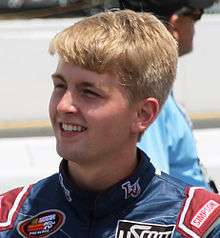
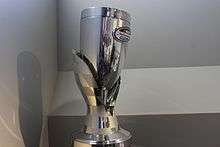
- Xfinity Series
- 2017 William Byron (Owners Championship – No. 22 Team Penske)
- 2016 Daniel Suárez (Owners Championship – No. 19 Joe Gibbs Racing)
- 2015 Chris Buescher (Owners Championship – No. 22 Team Penske)
- Nationwide Series
- 2014 Chase Elliott (Owners Championship – No. 22 Team Penske)
- 2013 Austin Dillon (Owners Championship – No. 22 Penske Racing)
- 2012 Ricky Stenhouse Jr. (Owners championship – No. 18 Joe Gibbs Racing)
- 2011 Ricky Stenhouse Jr. (Owners Championship – No. 60 Roush Fenway Racing)
- 2010 Brad Keselowski (Owners Championship – No. 18 Joe Gibbs Racing)
- 2009 Kyle Busch
- 2008 Clint Bowyer (Owners Championship – No. 20 Joe Gibbs Racing)
- Busch Series
- 2007 Carl Edwards
- 2006 Kevin Harvick (Owners Championship – No. 29 Richard Childress Racing)
- 2005 Martin Truex Jr.
- 2004 Martin Truex Jr.
- Busch Series Grand National Division
- 2003 Brian Vickers (Owners Championship – No. 21 Richard Childress Racing)
- 2002 Greg Biffle
- 2001 Kevin Harvick
- 2000 Jeff Green
- 1999 Dale Earnhardt Jr.
- 1998 Dale Earnhardt Jr.
- 1997 Randy LaJoie
- 1996 Randy LaJoie
- 1995 Johnny Benson
- Busch Grand National Series
- 1994 David Green
- 1993 Steve Grissom
- 1992 Joe Nemechek
- 1991 Bobby Labonte
- 1990 Chuck Bown
- 1989 Rob Moroso
- 1988 Tommy Ellis
- 1987 Larry Pearson
- 1986 Larry Pearson
- 1985 Jack Ingram
- 1984 Sam Ard
- Budweiser Late Model Sportsman Series
- 1983 Sam Ard
- 1982 Jack Ingram
- Late Model Sportsman Division
- 1981 Tommy Ellis
- 1980 Morgan Shepherd
- 1979 Gene Glover
- 1978 Butch Lindley
- 1977 Butch Lindley
- 1976 L. D. Ottinger
- 1975 L. D. Ottinger
- 1974 Jack Ingram
- 1973 Jack Ingram
- 1972 Jack Ingram
- 1971 Red Farmer
- 1970 Red Farmer
- 1969 Red Farmer
- 1968 Joe Thurman
- Sportsman Division
- 1967 Pete Hamilton
- 1966 Don MacTavish
- 1965 Rene Charland
- 1964 Rene Charland
- 1963 Rene Charland
- 1962 Rene Charland
- 1961 Dick Nephew
- 1960 Bill Wimble
- 1959 Rick Henderson
- 1958 Ned Jarrett
- 1957 Ned Jarrett
- 1956 Ralph Earnhardt
- 1955 Billy Myers
- 1954 Danny L. Graves
- 1953 Johnny Roberts
- 1952 Mike Klapak
- 1951 Mike Klapak
- 1950 Mike Klapak
Rookie of the Year Award winners
- 2017 William Byron
- 2016 Erik Jones
- 2015 Daniel Suárez
- 2014 Chase Elliott
- 2013 Kyle Larson
- 2012 Austin Dillon
- 2011 Timmy Hill
- 2010 Ricky Stenhouse Jr.
- 2009 Justin Allgaier
- 2008 Landon Cassill
- 2007 David Ragan
- 2006 Danny O'Quinn Jr.
- 2005 Carl Edwards
- 2004 Kyle Busch
- 2003 David Stremme
- 2002 Scott Riggs
- 2001 Greg Biffle
- 2000 Kevin Harvick
- 1999 Tony Raines
- 1998 Andy Santerre
- 1997 Steve Park
- 1996 Glenn Allen Jr.
- 1995 Jeff Fuller
- 1994 Johnny Benson
- 1993 Hermie Sadler
- 1992 Ricky Craven
- 1991 Jeff Gordon
- 1990 Joe Nemechek
- 1989 Kenny Wallace
All-time win table
All figures correct as of the 2018 Bar Harbor 200 Dover International Speedway (October 7, 2018).[17]
- Indicates driver that competed full-time in the 2018 season.
- Indicates driver that competed part-time in the 2018 season.
- Indicates driver has been inducted into the NASCAR Hall of Fame.
Most wins at each track
Current tracks
Former tracks
| Track | Driver | Wins |
|---|---|---|
| Gateway Motorsports Park | Carl Edwards | 3 |
| Gresham Motorsports Park | Larry Pearson | 2 |
| Hickory Motor Speedway | Jack Ingram & Tommy Houston | 8 |
| Langley Speedway | Tommy Ellis | 5 |
| Lucas Oil Raceway | Morgan Shepherd & Kyle Busch | 3 |
| Martinsville Speedway | Sam Ard | 5 |
| Memphis Motorsports Park | Kevin Harvick | 2 |
| Milwaukee Mile | Greg Biffle & Carl Edwards | 2 |
| Myrtle Beach Speedway | Jimmy Spencer & Jeff Green | 2 |
| Nashville Superspeedway | Carl Edwards | 5 |
| Nazareth Speedway | Tim Fedewa & Ron Hornaday Jr. | 2 |
| North Wilkesboro Speedway | Sam Ard | 2 |
| Orange County Speedway | Jack Ingram | 5 |
| Oxford Plains Speedway | Chuck Bown | 2 |
| Rockingham Speedway | Mark Martin | 11 |
| South Boston Speedway | Tommy Ellis | 7 |
List of manufacturers' championship winners
| Year | Manufacturer |
|---|---|
| 1982 | Pontiac |
| 1983 | Oldsmobile |
| 1984 | Pontiac |
| 1985 | |
| 1986 | |
| 1987 | Chevrolet |
| 1988 | Buick |
| 1989 | |
| 1990 | |
| 1991 | Oldsmobile |
| 1992 | Chevrolet |
| 1993 | |
| 1994 | |
| 1995 | Ford |
| 1996 | Chevrolet |
| 1997 | |
| 1998 | |
| 1999 | |
| 2000 | |
| 2001 | |
| 2002 | Ford |
| 2003 | Chevrolet |
| 2004 | |
| 2005 | |
| 2006 | |
| 2007 | |
| 2008 | Toyota |
| 2009 | |
| 2010 | |
| 2011 | Ford |
| 2012 | Chevrolet |
| 2013 | Ford |
| 2014 | Chevrolet |
| 2015 | |
| 2016 | Toyota |
| 2017 | Chevrolet |
See also
| Wikimedia Commons has media related to NASCAR Xfinity Series. |
References
- ↑ Ryan, Nate (September 18, 2013). "Nationwide to end sponsorship of NASCAR's No. 2 series". USA Today. Retrieved September 18, 2013.
- ↑ "NASCAR names XFINITY as new series sponsor". September 3, 2014. Retrieved September 3, 2014.
- ↑ The Busch Series dilemma Archived December 1, 2006, at the Wayback Machine.
- ↑ "Nationwide Insurance to be sponsor of No. 2 Series". Retrieved July 14, 2018.
- ↑ NASCAR Scene, October 11, 2007, Vol. XXXI – No. 24, p. 32.
- ↑ Mickle, Tripp (August 28, 2014). "Comcast, NASCAR To Announce 10-Year Deal Next Week For Xfinity To Title No. 2 Series". Sports Business Journal. Retrieved September 1, 2014.
- ↑ "Chase format extended to XFINITY, Camping World Truck Series". NASCAR.com. Daytona Beach, Florida: NASCAR Media Group, LLC. January 19, 2016. Retrieved January 19, 2016.
- ↑ "SI debuts TV partnership with Asian network ASN". Retrieved July 14, 2018.
- ↑ Speedwaymedia.com Archived January 5, 2009, at the Wayback Machine. "The Dangers of Bushwhacking" Retrieved May 23, 2009
- ↑ Menzer, Joe (October 26, 2016). "NASCAR to limit Premier Series driver participation in lower series". Foxsports.com. Retrieved October 26, 2016.
- ↑ "09/08/2007 race: Chevy Rock & Roll 400 (Cup) - Racing-Reference.info". www.racing-reference.info. Retrieved July 14, 2018.
- ↑ Thatsracin.com "NASCAR races in the rain in Montreal". Retrieved January 23, 2009.
- ↑ "Yahoo! Canada Sports – Sports News, Scores, Rumors, Fantasy Games, and more". Ca.sports.yahoo.com. Archived from the original on August 9, 2011. Retrieved July 13, 2010.
- ↑ Mark Aumann (October 28, 2007). "COT planned for 2009 Nationwide Series debut – Oct 28, 2007". Nascar.Com. Retrieved July 13, 2010.
- ↑ "Yahoo! Canada Sports – Sports News, Scores, Rumors, Fantasy Games, and more". Ca.sports.yahoo.com. Archived from the original on August 9, 2011. Retrieved July 13, 2010.
- ↑ "2019 Toyota Supra Xfinity Series Race Car | Toyota Nascar". www.toyota.com. Retrieved 2018-09-21.
- ↑ "NASCAR Xfinity Series Page". Racing-Reference.info. Retrieved April 24, 2014.
